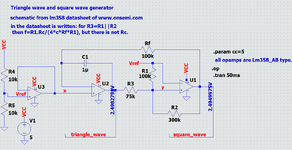akbarza
Full Member level 2

hi
I found the below schematic in an Lm358 datasheet that belongs to www.onsemi.com.
by attention to the pic, in the datasheet is written that for R3=R1||R2 then the oscillation frequency is f=R1*Rc/(4*c*Rf*R1). but there is no Rc in the schematic.
1)how can analyze the circuit to obtain a formula for frequency?
2)can explain to me why in node triangle_wave, the shape of oscillation is a triangle wave, and also for node square_wave?
3) as we know this circuit will be connected to another circuit and it causes a load effect. How can I import the role of load in the schematic?
4)suppose the design is for a special frequency and R's and c are determined for that frequency. is there any condition on Opamp as Unity gain bandwidth or others that Opamp must satisfy?
thanks
I found the below schematic in an Lm358 datasheet that belongs to www.onsemi.com.
by attention to the pic, in the datasheet is written that for R3=R1||R2 then the oscillation frequency is f=R1*Rc/(4*c*Rf*R1). but there is no Rc in the schematic.
1)how can analyze the circuit to obtain a formula for frequency?
2)can explain to me why in node triangle_wave, the shape of oscillation is a triangle wave, and also for node square_wave?
3) as we know this circuit will be connected to another circuit and it causes a load effect. How can I import the role of load in the schematic?
4)suppose the design is for a special frequency and R's and c are determined for that frequency. is there any condition on Opamp as Unity gain bandwidth or others that Opamp must satisfy?
thanks




